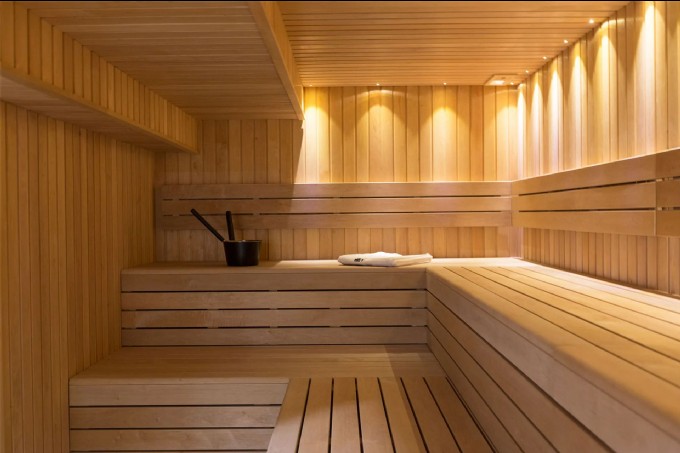Fabulous
Benefits of Sauna: Provides Mind and Body Comfort
When you’re staying at a resort for a ski weekend or booking a rental in the mountains, having a hot tub and a sauna feels like the ultimate luxury. After putting your body to work crisscrossing down the slopes or hiking for miles, there’s no denying that saunas make us all feel good. The heat releases tension, soothes muscles, and helps you sweat out any lingering stress.

But do saunas offer real health benefits, or are they a relaxing (sometimes expensive) treat that most of us don’t get to experience regularly in our daily lives?
We asked Mahmud Kara, M.D., internal medicine doctor, functional medicine specialist, and founder of KaraMD about the health benefits of saunas, different types of saunas available, and more.
What exactly is a sauna?
When you imagine a sauna, you might instantly picture yourself sweating it out in a wooden enclosure, surrounded by snow outside—ideally in Finalnd. And you would be right—generally speaking, Dr. Kara says saunas are enclosed rooms that use dry heat from sources like hot rocks to raise the temperature without raising the humidity.
Saunas vary in size and set-up and can be found in multiple locations, including gyms, spas, or even personal saunas for at-home use. Dr. Kara says there are a variety of sauna types.
Types of Saunas
Electric: Electric saunas typically use an electric heat source, like a stove top, to raise the temperature of large rocks or stones. They then retain heat without lifting the humidity of a room.
Wood-burning: Dr. Kara says a wood-burning sauna is similar to an electric sauna, but more of the traditional version of a sauna that uses wood to heat the stones or rocks. These often omit the fragrance of a fireplace, creating an even more cozy, sensory experience.
Infrared: Dr. Kara says this tech-focused type of sauna is a more modern approach that uses infrared waves to heat the body directly rather than an entire room. Many infrared saunas look like an old-school tanning bed or a sleeping bag to lock in the heat.
Steam: Also called ‘steam rooms,’ steam saunas typically use a generator or machine that boils water, turns it into steam, and releases it into an enclosed room.
Smoke: This type of sauna functions like a wood sauna, except there is no chimney, so the smoke fills an enclosed area, Dr. Kara explains. Then, once the room reaches the desired temperature and comfort level, the fire that produces the smoke is put out.
Sauna Health Benefits
Whether you go the classic wood-burning sauna or the modern infatuated sauna route, is this luxury experience truly beneficial for our health? Or are they merely a high-end way to chill out?
A little bit of both, actually, according to Dr. Kara. Saunas have been studied and found to impact our health in many ways. A huge factor: Saunas make you sweat, and normal sweating is extremely healthy for everything from natural detoxification, skin health and hydration, heart health, and boosting happiness hormones.
Saunas promote relaxation and help relieve stress
With chaotic, overbooked, busy work and personal schedules, most people feel pushed to their limits and close (if not at) to burnout levels. Chronic stress can wreak havoc on our bodies internally and externally, and saunas have been shown to reduce stress build-up by helping us relax.
Saunas benefit cardiovascular health.
Finnish research found that subjects who frequented saunas four to seven times per week had lower sudden cardiac death, lower fatal coronary heart disease, fatal cardiovascular disease, and all-cause mortality, compared to those who took saunas one, two, or three times per week. Results from another prospective cohort study out of in Eastern Finland suggested that regular sauna bathing was associated with reduced risk of hypertension.
Saunas may help reduce chronic inflammation.
If you’re wondering how to lower chronic inflammation in your system and get back to feeling like your best self, you might want to hit the sauna. A growing body of research shows promising effects of frequent sauna-bathing on several markers of acute and systemic inflammation, including helping to lower something called C-reactive protein, a leading biomarker of systemic inflammation.
Saunas can ease joint and muscle tension.
One of the reasons ski resorts have hot tubs, saunas, and/or steam rooms is purely based on science: heat plays a factor in helping our bodies release muscle tension and the aches and pains that come with fitness-related exertion. Furthermore, Dr. Kara says saunas help relax the blood vessels and dilate them, which is essential for increasing blood flow and can help with recovery after exercise and cardiovascular health.
Saunas may help remove toxins from the body.
Latest News
When you’re staying at a resort for a ski weekend or booking a rental in the mountains, having a hot tub and a sauna feels like the ultimate luxury. After putting your body to work crisscrossing down the slopes or hiking for miles, there’s no denying that saunas make us all feel good. The heat releases tension, soothes muscles, and helps you sweat out any lingering stress.

But do saunas offer real health benefits, or are they a relaxing (sometimes expensive) treat that most of us don’t get to experience regularly in our daily lives?
We asked Mahmud Kara, M.D., internal medicine doctor, functional medicine specialist, and founder of KaraMD about the health benefits of saunas, different types of saunas available, and more.
What exactly is a sauna?
When you imagine a sauna, you might instantly picture yourself sweating it out in a wooden enclosure, surrounded by snow outside—ideally in Finalnd. And you would be right—generally speaking, Dr. Kara says saunas are enclosed rooms that use dry heat from sources like hot rocks to raise the temperature without raising the humidity.
Saunas vary in size and set-up and can be found in multiple locations, including gyms, spas, or even personal saunas for at-home use. Dr. Kara says there are a variety of sauna types.
Types of Saunas
Electric: Electric saunas typically use an electric heat source, like a stove top, to raise the temperature of large rocks or stones. They then retain heat without lifting the humidity of a room.
Wood-burning: Dr. Kara says a wood-burning sauna is similar to an electric sauna, but more of the traditional version of a sauna that uses wood to heat the stones or rocks. These often omit the fragrance of a fireplace, creating an even more cozy, sensory experience.
Infrared: Dr. Kara says this tech-focused type of sauna is a more modern approach that uses infrared waves to heat the body directly rather than an entire room. Many infrared saunas look like an old-school tanning bed or a sleeping bag to lock in the heat.
Steam: Also called ‘steam rooms,’ steam saunas typically use a generator or machine that boils water, turns it into steam, and releases it into an enclosed room.
Smoke: This type of sauna functions like a wood sauna, except there is no chimney, so the smoke fills an enclosed area, Dr. Kara explains. Then, once the room reaches the desired temperature and comfort level, the fire that produces the smoke is put out.
Sauna Health Benefits
Whether you go the classic wood-burning sauna or the modern infatuated sauna route, is this luxury experience truly beneficial for our health? Or are they merely a high-end way to chill out?
A little bit of both, actually, according to Dr. Kara. Saunas have been studied and found to impact our health in many ways. A huge factor: Saunas make you sweat, and normal sweating is extremely healthy for everything from natural detoxification, skin health and hydration, heart health, and boosting happiness hormones.
Saunas promote relaxation and help relieve stress
With chaotic, overbooked, busy work and personal schedules, most people feel pushed to their limits and close (if not at) to burnout levels. Chronic stress can wreak havoc on our bodies internally and externally, and saunas have been shown to reduce stress build-up by helping us relax.
Saunas benefit cardiovascular health.
Finnish research found that subjects who frequented saunas four to seven times per week had lower sudden cardiac death, lower fatal coronary heart disease, fatal cardiovascular disease, and all-cause mortality, compared to those who took saunas one, two, or three times per week. Results from another prospective cohort study out of in Eastern Finland suggested that regular sauna bathing was associated with reduced risk of hypertension.
Saunas may help reduce chronic inflammation.
If you’re wondering how to lower chronic inflammation in your system and get back to feeling like your best self, you might want to hit the sauna. A growing body of research shows promising effects of frequent sauna-bathing on several markers of acute and systemic inflammation, including helping to lower something called C-reactive protein, a leading biomarker of systemic inflammation.
Saunas can ease joint and muscle tension.
One of the reasons ski resorts have hot tubs, saunas, and/or steam rooms is purely based on science: heat plays a factor in helping our bodies release muscle tension and the aches and pains that come with fitness-related exertion. Furthermore, Dr. Kara says saunas help relax the blood vessels and dilate them, which is essential for increasing blood flow and can help with recovery after exercise and cardiovascular health.
Saunas may help remove toxins from the body.

Jennifer Lopez looks ageless in a towel in no-makeup video

Amanda Holden spanks her derriere and thanks Spanx

Amanda Holden shows off more than bargained as she dances around in her outfit of the day

Meet Harley Cameron, the stunning model who went from a BKFC ring girl to become a pro wrestler and found love

GreenGirlBella, Rocks Emirates Stadium in Painted Home Kit

Amanda Holden calls herself a 'good girl' in white dress with 'cheeky' split

Mum slammed by parents after flashing thong in school run outfit

Lottie Moss makes jaws dropp as she shows off her flawless body

Amanda Holden wears nothing beneath plunging white dress












Comments
Written news comments are in no way https://www.showbizglow.com it does not reflect the opinions and thoughts of. Comments are binding on the person who wrote them.